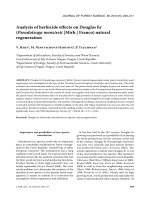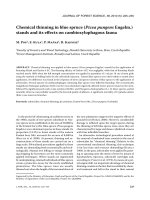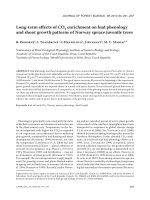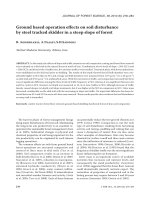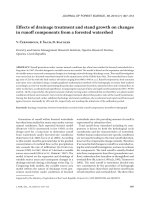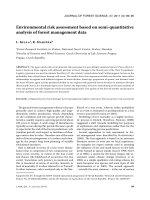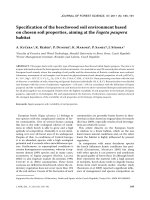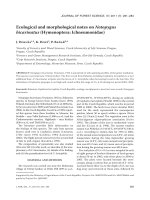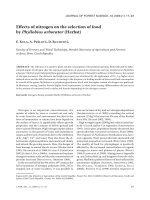Báo cáo lâm nghiệp: "Ground based operation effects on soil disturbance by steel tracked skidder in a steep slope of forest" ppt
Bạn đang xem bản rút gọn của tài liệu. Xem và tải ngay bản đầy đủ của tài liệu tại đây (262.6 KB, 7 trang )
278 J. FOR. SCI., 56, 2010 (6): 278–284
JOURNAL OF FOREST SCIENCE, 56, 2010 (6): 278–284
e harvest phase of forest management brings
along major disturbances of forest soil. Maintaining
the long-term site productivity is an essential re-
quirement for sustainable forest management (A
et al. 2005). Substantial changes in physical and
chemical properties of soil being important for the
site productivity can be originated by such intense
logging operations.
e common effects on soils from ground based
forest operations are increased compaction and
removal of litter mass in skid trails (T et al.
2008). Soil compaction results in an increase in
bulk density (B et al. 2002; D et al. 2007;
M et al. 2007), reduction in macroporos-
ity (R et al. 2004; A et al. 2007),
saturated hydraulic conductivity (W et al.
2003; G et al. 2006), water content, infiltra-
tion (S, MN 2000), N mineralization
and microbial number biomass and activity (A
et al. 2005; T et al. 2008). Each of these features
can potentially reduce the tree growth (F
1979; C 1998). Compaction is not the only
type of soil disturbance resulting from harvesting
activity, soil mixing, puddling and rutting that can
cause a disruption of matter flow are also some
other examples of disturbance. Ruts may become
channels for surface runoff and thus cause erosion
since the infiltration of rainwater is reduced (J-
, J 1998; G 2000; B et
al. 2004). MD et al. (1995) found that the
frequency of skidder traffic was the most significant
factor influencing the rut formation.
Litter mass is an important source of available
nutrients that increases soil nutrient levels and
consequently the stand productivity. Z
et al. (1994) suggested that the forest floor removal
could dramatically intensify nutrient export. e
restoration of properties of compacted soil in the
lasting process may require between 5 and 40 years
to recover (J 1983; C et al. 2001).
Ground based operation effects on soil disturbance
by steel tracked skidder in a steep slope of forest
B. A, A.N, S.H.S
Tarbiat Modares University, Tehran, Iran
ABSTRACT: In this study, the effects of slope and traffic intensity on soil compaction, rutting and forest floor removal
was evaluated on a skid trail in the natural forest of north of Iran. Combination of two levels of slope < 20% (SC1) and
> 20% (SC2) and three levels of traffic (one, five and nine traffics) were studied. Treatment plots, with three replications,
were established on the skid trail prior to skidding. e results of this study showed that all bulk densities were con-
siderably higher in SC2 than in SC1 and average soil bulk densities were measured from 1.07 (gcm
–3
) to 1.23 (gcm
–3
)
on skid trail and 0.91 (gcm
–3
) in undisturbed areas. With the increment of traffic, soil compaction increased but there
was no significant difference among the three levels of traffic frequency in SC1 whereas it was significant between one
and five cycles in SC2. Greatest rut depth was measured as 12 cm at nine traffics in SC2, although increase of traffic
density caused deeper rut depth at all slope treatments, but it was higher at the SC2 in comparison to SC1. Litter mass
decreased considerably on the skid trail with the increasing in slope and traffic. No important difference has been de-
tected between SC1 and SC2 in terms of Litter mass removal. ese results provide clear evidence that soil disturbance
on steep trail is intensified.
Keywords: crawler tractor; forest floor removal; ground based skidding; hardwood forest of Iran; soil compaction
J. FOR. SCI., 56, 2010 (6): 278–284 279
Several studies have examined the relationship
between soil disturbance and the associated number
of loaded machine passes. e majority of previous
studies investigated the effects of wheeled skidders
on soil disturbance while a few studies assessed the
impacts of steel tracked skidders whereas in many
forest areas, particularly in steep terrain with large
trees and high precipitation rates, these machines
are likely to remain the most common type of skid-
ding machine used.
In mountainous and steep areas, the terrain slope
is an important factor that affects operational ef-
ficiency, costs and erosion. It may also affect the soil
compaction, so in planning forest operations and
aligning skid trails the terrain slope may be an im-
portant consideration for protecting soil resources
(J et al. 2008).
e objectives of this investigation were to (1) as-
sess the soil disturbance after ground based logging
by a steel tracked skidder and (2) determine the ef-
fects of slope on the soil disturbance in a skid trail.
MATERIAL AND METHODS
A field study was conducted at a Forestry Ex-
perimental Station of Tarbiat Modares University,
located in a temperate forest in the north of Iran,
between 36°31'56''N and 36°32'11''N latitudes and
51°47'49''E and 51°47'56''E longitudes, in February
2008. e elevation is approximately 650 m a.s.l. with
western aspect, while the average annual rainfall of
1,308 mm has been recorded.
e natural vegetation is a deciduous forest with
dominant species of hornbeam (Carpinus betulus
[L.]) and beech (Fagus orientalis Lipsky).
Soil samples for detecting the soil texture were
collected at ten random points from the top of the
50 cm deep soil profile from an undisturbed area,
thus the soil texture was analyzed by the Bouyoucos
hydrometer method and the range from loamy to
silt loamy soil was determined. Soil water content at
the time of skidding on the slope < 20% (SC1) and
on the slope > 20% (SC2) was 31% and 28%, respec-
tively. e harvested trees were 80–130 years old and
the average diameter at breast height was 80 cm. A
300 m long skid trail was delineated as the research
area, passing through the stand in east-west direc-
tion. Two slope classes, slope < 20% (SC1) and slope
> 20% (SC2), were identified on the skid trail.
A 150 m long straight skid trail was selected in
each slope class. Treatment plots 4 m wide by 10 m
long were delineated prior to skidding and assigned
to six combinations of slope classes (SC1 and SC2)
and traffic intensities (one, five and nine traffics)
with at least 5 m buffer zone between plots to avoid
interactions. Treatment plots with three replications
included three randomized line samples across the
chain rut perpendicular to the direction of travel
with 1 m buffer zone between lines to avoid interac-
tions. In this study, a fixed log (diameter 80 cm and
length 3.6 m) was hauled by a steel tracked skidder
TLT-100A (Table 1) in all treatments.
The effects of skid trail slope and traffic on the
surface soil layer (0 to 10 cm deep) were studied
using dry bulk density, rut depth and litter mass
removal, in comparison with an undisturbed area
at different levels of slope and traffic. All samples
were collected in two tracks in each plot after one,
five and nine traffics in each slope class. The soil
samples were gathered using 10 cm high steel cy-
linders 6 cm in diameter from 10 cm depth and
were put in double plastic, and then labelled sam-
ples were brought to a laboratory from the research
area. The samples of litter mass were taken from
0.5 m
2
area by collecting all the litter mass in that
area. Rut depths were measured in the same points
of soil samples, a wooden rod was laid across the
rut and the distance from the ground surface to
the underside of the rod was measured between
the holes for the probes. The percentage of mois-
ture was calculated from weight values of wet and
oven-dried samples after the litter cover samples
were dried in an oven at 65°C and soil samples were
dried at 105°C, both for 24 h.
Data analysis was completed by SPSS statistical
software (version: 12). Treatment effects were tested
using analyses of variance (ANOVA) with slope
classes and traffic levels. Independent sample t-test
slope compared the differences in mean soil bulk
density, rut depth and litter mass removal between
two slope classes at a 0.05 significance level.
Table 1. Technical description of steel tracked skidder
LTT-100A
Length 6 m
Width 2.6 m
Track 3 m
Operation power 88.2 KWt
Ground unit pressure 0.049 MPa
Track-driving sprockets cast-steel tooth wheel
Pressure in hydraulic system 14 MPa
Number of teeth 9
Width of caterpillar 44 cm
Tractor mass maintenance 11,200 kg
280 J. FOR. SCI., 56, 2010 (6): 278–284
RESULTS AND DISCUSSION
A significant soil compaction occurred on the skid
trail in comparison with the undisturbed area, due
to high traffic and slope applied. Post-harvesting soil
bulk density was measured as minimum 1.07 gcm
–3
to maximum 1.23 gcm
–3
while the soil bulk density
of 0.91 gcm
–3
was already recorded prior to skidding
(Table 2). erefore bulk density generally increased
with an increase in traffic at all levels of slope.
Although the bulk density increment was meas-
ured with an increase in traffic frequency, the in-
crement varied between two slope classes (Fig. 1).
According to Fig. 1 the absence of significant differ-
ences in bulk density among the traffic treatments in
SC1 could be explained by the fact that the highest
soil compaction occurs after the first several traffics
(MN et al. 2000). Although additional passes on
the soils are unlikely to increase the bulk density, the
continued trafficking of adjacent soil when wet did
cause some rutting (MN et al. 2000). Once this
initial compaction is complete, further compaction is
resisted by the increasing soil strength and is there-
fore considerably slower (W, N
2000; N et al. 2003; H et al. 2004). ere-
fore these results are in accordance with results of
J and J (1988), G (2000),
B et al. (2004) and A et al. (2007).
A considerably higher value of bulk density was
recorded in SC2 at all levels of traffic in comparison
with SC1 (Table 2). A maximal significant increase in
bulk density occurs in SC1 after one pass (17.6%). In
SC1 and SC2, the percentage of change in bulk den-
sity after the first traffic was 17.6% and 21%, respec-
tively. e USDA forest service has used a threshold
value of 15% increase in bulk density for determining
detrimental soil compaction in their monitoring
programs (P et al. 1999). Applying these
standards to our data, it can explicitly realize that the
threshold of detrimental compaction was exceeded
in the first traffic. e increment of bulk density in
terms of percentage in SC1 was 3%, 6% and 8% at
the one, five and nine traffic frequency, respectively.
e significant increase in soil bulk density in SC2
can be interpreted that the movement of a vehicle on
the slope causes a high stress, even under the front
chain-saw track, which is frequently unloaded as the
weight of the vehicle is transferred to the low contact
area (M et al. 1998). Another reason could be
that the average speed of machines was lower com-
pared to SC1. When the skidder passes more slowly
on a steep slope, the top soil is obviously vibrated
Table 2. Percentage of increasing in soil bulk density (gcm
–3
) from post-skidding to pre-skidding for each slope class
and effect of slope on soil bulk density
No. of passages
SC1 SC2
pre-skidding post-skidding changes (%) post-skidding changes (%)
1
5
9
0.91
0.91
0.91
1.07*
a
1.11*
b
1.12*
b
17.6
22
24.2
1.1*
a
1.18*
a
1.23*
a
21
29.8
35.2
*Significance level α = 0.05
Mean results are flanked on the same line by letters. Each two means shared a results do not differ significantly
1.4
1.2
1.0
0.8
0.6
0.4
0.2
0.0
Soil bulk density (g
.
cm
–3
)
traffic 1
traffic 5
traffic 9
a
b
b
a
a
a
SC1 SC2
Fig. 1. Effect of traffic on soil bulk density at
separated analyses for each slope class
J. FOR. SCI., 56, 2010 (6): 278–284 281
more and consequently gets more disturbances com-
pared to a gentle trail (N et al. 2009).
As a whole, the effects of slope and traffic fre-
quency significantly influenced bulk density changes
(P < 0.001) but the interaction between slope and
traffic frequency was not significant (P = 0.254)
(Table 3).
Analyses of measured rut depths confirm that
the rut depth increased with an increase in traffic
intensity. us our results are in accordance with
findings of many researchers (MN et al. 2000;
E 2007; E, W 2007).
In both slope classes, rut depths increased with the
increase in traffic but the extent of rut depths varied
between slope classes (Table 4). In all traffics, the rut
depth in SC2 was higher than in SC1 and the high-
est depth value was at nine traffics in SC2 (Fig. 2).
e rut depth in SC1 and SC2 was 9 cm and 12 cm,
respectively. Results of the rut depth suggest that
logging and skidding on steep slopes have a pro-
nounced effect on the rutting. In up-slope moving,
Table 3. Analysis of variance (ANOVA) for the effects of slope and traffic on soil compaction, rutting and litter mass
removal
Source P F MS df Type III SS
Compaction
Traffic 0.001* 8.303 0.052 2 0.150
Slope 0.000* 16.005 0.101 1 0.101
Traffic × slope 0.254 1.396 0.009 2 0.018
Rutting
Traffic 0.000* 237.893 736.714 2 1,473.428
Slope 0.000* 57.538 178.186 1 178.186
Traffic × slope 0.000* 9.384 29.061 2 58.122
Litter mass removal
Traffic 0.000* 500.101 9,954,233.33 2 9,344.44
Slope 0.498 0.469 9,344.444 1 199,088,466.6
Traffic × slope 0.001* 8.173 162,677.77 2 325,355.556
* Significance level α = 0.05
14
12
10
8
6
4
2
0
Rut depth (cm)
traffic 1
traffic 5
traffic 9
b
a
SC1 SC2
a
b
b
c
Fig. 2. Effect of traffic on rut depth sepa-
rated analyses for at each slope class
Table 4. Effect of slope on rut depth (cm)
P
Slope class
Traffic
SC2 SC1
0.964 2.4 2.2 1
0.000* 10.5 6.9 5
0.000* 12.0 9.2 9
*Significance level α = 0.05
282 J. FOR. SCI., 56, 2010 (6): 278–284
travel speed and the power of the machine are lim-
ited and accrued rutting and mixing of mineral soil
with litter mass by the track grouser of this machine
type. However, the large ground contact area of this
machine results in high tractive efficiencies, low
ground pressures and good stability on steep slopes.
e rut depth is often the only criterion that forest
managers have to assess soil damage as harvesting
occurs (L, R 2000) and is often used in
visual assessments of site productivity changes be-
cause they indicate changes in infiltration, erosion,
water retention and the water-air balance as an early
indicator of altered productivity (S
et al. 2000). Common descriptors include undis-
turbed and three categories of disturbance: light
disturbance, with shallow scarification; moderate
disturbance, secondary skid trails or compaction
and/or rutting up to 5–8 cm deep; heavy distur-
bance, primary skid trails, landings, or rutting at
least 10–15 cm deep (G 2000). According to
results of the present study, the categories of soil
disturbance were moderate and heavy disturbance
for SC1 and SC2, respectively.
A comparison of rut depths at each level of traffic
using t-test analyses showed that irrespective of the
slope class, the rut depth increase at five and nine
traffics was significant (Table 4). e results showed
that traffic and slope, and also traffic × slope inter-
action affected the rutting significantly (P < 0.001)
(Table 3).
Litter mass removal was also quantified by measur-
ing the displacement of litter mass on the skid trail
after skidding. Total litter mass weight in unit area
was 5,567 kgha
–1
in undisturbed area. Litter mass
removal was not affected by the slope significantly
(P = 0.498) but the effects of traffic, and also of the
interaction between traffic and slope on litter mass
removal were significant (P < 0.001) (Table 3). At all
levels of the slope, forest floor was removed signifi-
cantly after one traffic in comparison with general
harvesting area whereas the difference in forest floor
removal between five and nine passes was not signifi-
cant (Fig. 3). Reduction of litter mass following the
first traffic on the skid trail area was approximately
60% in both slope classes. In ground-based skidding
some of the trees along the skid trail were cut during
the construction of skid trail in order to prevent any
preclusion on skid trail works (D et al. 2007;
M et al. 2007) since the mixing of mineral
soil with litter mass in this type of machines is high,
therefore considerably less litter mass on the skid
trail is obvious.
CONCLUSION
is study was conducted with the overall objec-
tive of describing the effects of the slope of skid trail
and traffic frequency on soil compaction, rutting and
litter mass removal. Although the damage resulting
from logging traffic for forest harvesting that differs
between treatments was significant; soil disturbance
(soil compaction and rutting) occurs on slopes > 20%
and can be of ecological importance. No significant
differences were found in forest floor removal be-
tween slope classes in response to traffic frequency.
e relative increase in soil bulk density was less for
SC1 following traffic, thus the skidding operations on
the slope of smaller gradient were found to be more
reasonable to alleviate the effects of subsequent ma-
chine traffic. Prompt actions should be taken in order
to prevent and minimize negative impacts of soil
disturbance in logging forest. Especially, the skidding
operations should be limited on the slope of < 20 %.
A practical recommendation would be to minimize
traffic in order to affect the soil as little as possible.
R e f er en ce s
A E., G R.W.M., C W. M., V
K. (2007): Impact of mechanized logging on compaction
6,000
5,000
4,000
3,000
2,000
1,000
0
Forest floor mass (kg
.
ha
–1
)
undisturbed
traffic 1
traffic 5
traffic 9
a
SC1 SC2
a
c
b
c
b
c
c
Fig. 3. Effect of traffic on litter mass
removal at separated analyses for each
slope class
J. FOR. SCI., 56, 2010 (6): 278–284 283
status of sandy forest soils. Forest Ecology and Manage-
ment, 42: 162–174.
A A., T T.A., M R.E., A H.W., F-
B.L. (2005): Ground-based forest harvesting effects on
soil physical properties and Douglas-fir growth. Soil Science
Society of America Journal, 69: 1822–1832.
B R., V R K.C.J., P D.J. (2002): Quantifying
harvesting impacts using soil compaction and disturbance
regimes at a landscape scale. Soil Science Society of America
Journal, 66: 1669–1676.
B G., E L., W I. (2004): Rut depth,
soil compaction and rolling resistance when using bogie
tracks. Journal of Terramechanics, 40: 179–190.
C I.G. (1998): Compaction by forestry equipment and ef-
fects on coniferous seedling growth on four soils in the Alberta
foothills. Canadian Journal of Forest Research, 18: 75–84.
C J., H P., F P. (2001): Soil recovery
from track construction and harvesting changes in surface
infiltration, erosion and delivery rates with time. Forest
Ecology and Management, 143: 3–12.
D M., M E., Y E. (2007): Investigation
of timber harvesting impacts on herbaceous cover, forest
floor and surface soil properties on skid road in an oak
(Quercus petrea L.) stand. Building and Environment, 42:
1194–1199.
E L. (2005): Effects of forwarder tyre pressure on
rut formation and soil compaction. Silva Fennica, 39:
549–557.
E L., W W. (2007): Effects of slash rein-
forcement of strip roads on rutting and soil compaction on
a moist fine-grained soil. Forest Ecology and Management,
252: 118–123.
F H.A. (1979): Soil compaction from logging equip-
ment: effects on growth of young ponderosa pine. Journal
of Soil Water Conservation, 34: 276–278.
G J.M.I., S R.W., C D.K. (2006): Soil physical
changes associated with forest harvesting operations on
an organic soil. Soil Science Society of America Journal,
70: 503–509.
G D.F. (2000). Effects of extensive forest management
on soil productivity. Forest Ecology and Management, 70:
167–185.
H R., V J., B S. (2004): Modern forestry
vehicles and their impacts on soil physical properties. Soil
and Tillage Research, 74: 207–219.
J B.F. (1983): Persistence of compaction effects in a for-
est Kraznozem. Australian Forest Research, 13: 305–308.
J R., J D., R N., T M. (2008):
Influence of two ground-based skidding systems on soil
compaction under different slope and gradient conditions.
Journal of Forest Engineering, 19: 9–16.
J K.J., J J. (1998): Soil changes after traffic
with a tracked and a wheeled forest machine: a case study
on a silt loam in Sweden. Forestry, 71: 57–66.
L S.T., R P.J. (2000): Cumulative management im-
pacts on soil physical properties and early growth of Pinus
radiata. Forest Ecology and Management, 138: 321–333.
M E., D M., C A., Y E. (2007):
Long-term harvesting effects on skid road in a fir (Abies
bornmulleriana Mattf.) plantation forest. Building and
Environment, 44: 1538–1543.
M A., S P., P M., V N. (1998):
Changes of some physical properties of a clay soil follow-
ing passage of rubber- and metal-tracked tractors. Soil and
Tillage Research, 49: 185–199.
MD T.P., S B.J., A W.M. (1995): Soil physi-
cal property changes after skidder traffic with varying tire
widths. Journal of Forest Engineering, 6: 41–50.
MN D.H., S A.D., N H. (2000): Soil wet-
ness and traffic level effects on bulk density and air-filled
porosity of compacted Boreal forest soils. Soil Science
Society of America Journal, 64: 1238–1247.
N A., S A., S S.H.R. (2009): Soil disturbance
following four wheel rubber skidder logging on the steep
trail in the north mountainous forest of Iran. Soil and Till-
age Research, 130: 165–169.
N C., K C., O P.M.O., N
M., W S. (2003): Characteristic site disturbance due
to harvesting and extraction machinery traffic on sensitive
forest sites with peat soils. Forest Ecology and Manage-
ment, 180: 85–98.
P R.F., T A.E., B J.R. (1999): Assessing soil
quality: practicable standards for sustainable forest produc-
tivity in the United States. In: e Contribution of soil sci-
ence to the development of and implementation of criteria
and indicators of sustainable sorest management. No. 53,
Soil Science Society of America, Madison, W.I, USA.
R K., A K A., H J., V J.C.
(2004): Changes in some mechanical properties of loamy
soil under the influence of mechanized forest exploitation
in a beech forest of central Belgium. Journal of Terrame-
chanics, 40: 235–253.
S S.H., V M H., B J.A. (2000):
A review of chemical and physical properties as indicators
of forest soil quality: challenges and opportunities. Forest
Ecology and Management, 138: 335–356.
S A.D., MN D.H. (2000): Effects of skidding on
forest soil infiltration in west-central Alberta. Canadian
Journal of Soil Science, 80: 617–624.
T X., C S.X., K R. (2008): Soil compaction
and forest floor removal reduced microbial biomass and
enzyme activities in a boreal aspen forest soil. Biology and
Fertility of Soils, 44: 471–479.
W J.R., N, W.A. (2000): The influence
of forest site on rate and extent of soil compaction and
profile disturbance of skid trails during ground-based
harvesting. Canadian Journal of Forest Research, 30:
1196–1205.
284 J. FOR. SCI., 56, 2010 (6): 278–284
W M.J., C P.A., M A.J. (2003): Improving the
design of slash roads used to reduce soil disturbance during
mechanized harvesting of coniferous forest plantations in
the UK. Journal of Forest Engineering, 14: 11–23.
Z D., S, M.F., R, P.T. (1994):
Timber harvesting and long-term productivity: weathering
Corresponding author:
A N, Ph.D., Tarbiat Modares University, Jalal Ale Ahmad Highway, P.O.Box: 14115-111, Tehran, Iran
tel.: + 981 226 253 101-3, fax: + 981 226 253 499, e-mail: najafi
processes and soil disturbance. Forest Ecology and Manage-
ment, 66: 55–68.
Received for publication September 23, 2009
Accepted after corrections November 2, 2009
